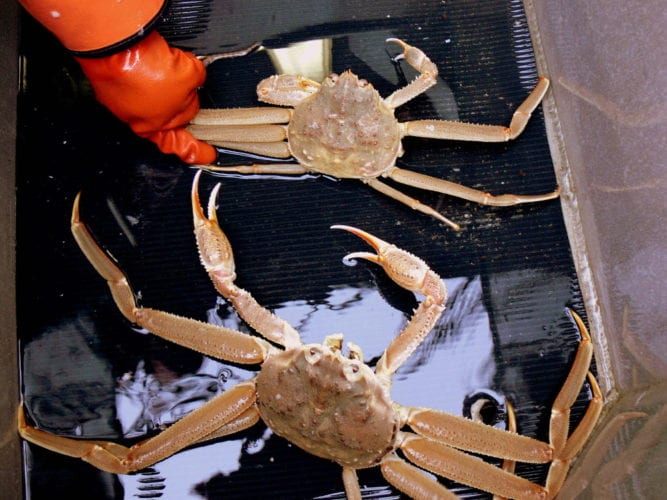The commercial catch of Tanner crab in Southeast Alaska last month fell well short of last year’s haul. The season was open in mid-February with six days of crabbing in a number of more popular core areas in the central and northern panhandle. Crabbing was open an additional five days in the non-core areas.
The overall catch for the season was 937,000 pounds. That’s down from last year’s catch of 1.3 million pounds.
Alaska Department of Fish and Game crab biologist Kellii Wood said this year’s catch is below the most recent catches. “The five-year average not including this last season is about 1.3 million pounds,” Wood said. “The 10-year average is about one million pounds. So it’s right on there, around the 10-year-average.”
Effort was down a little this year. 58 permit holders hauled in 98 percent of the catch using pot gear. Another 12 permit holders caught the remainder using ring nets. Wood explained that catches were down in the three top producing areas this year.
“The best district was district 11 which is around the Juneau area and they caught about 375,000 pounds,” she said. “Last year they caught 524,000 in that district. Second best was district 14, which is Icy Strait/Glacier Bay. They caught approximately 182,000 pounds. Last year they were third with 222,000 pounds. And coming in third was district 10, which is Fanshaw, Pybus, Gambier with 160,000 pounds and they came in second last year with 259,000 pounds.”
The catch in Frederick Sound was also down by 36 percent from last year. Crabbers saw a better price in 2017 though. The average price was $2.77 a pound, up from $2.23 last year. Overall the catch was worth 2.6 million dollars at the docks. The amount of bitter crab was down in this year’s catch. That’s crab infected with a parasite that makes it taste bad.
Meanwhile, some areas of Southeast remain open for golden king crab, although there hasn’t been as much interest in that fishery. That season opened along with Tanner crab on February 17. Catches of golden king crab have been poor in recent years and fishery managers have reduced harvest targets and closed crabbing in some areas early.
This year crabbers were able to catch the guideline harvest level in one area already. Northern Stephens Passage has closed with eight permit holders hauling in the eight thousand pounds by March 8th. Another area in east central Southeast closed March 25th because of stock health concerns and low catches. The GHL there is 15,000 pounds and as of mid-March the total catch was not even 500 pounds. Seven permit holders have been crabbing there. By late March nearly half of the guideline harvest level had been caught in both Icy Strait and in an area in northern Southeast.
Wood said not all who signed up for golden king crab opted to go out fishing. “As far as permits go we’ve only had reported landings from 16 permits and we had 28 registered at the start of the fishery so I think a lot of the guys that started out thinking that they were gonna go ended up not going. They just didn’t see that it was worth their time.”
The price averaged twelve dollars a pound for golden king crab. For the time being, the season remains open in five areas of Southeast.










